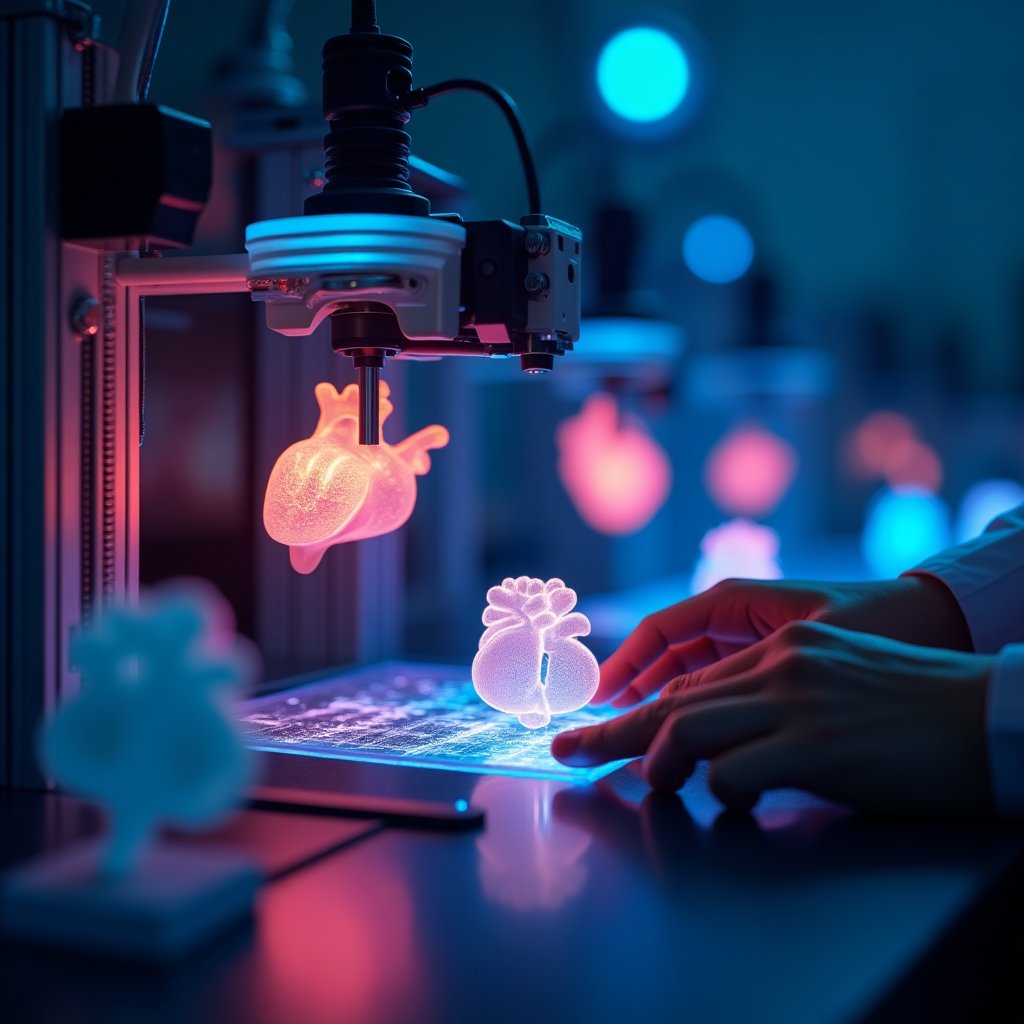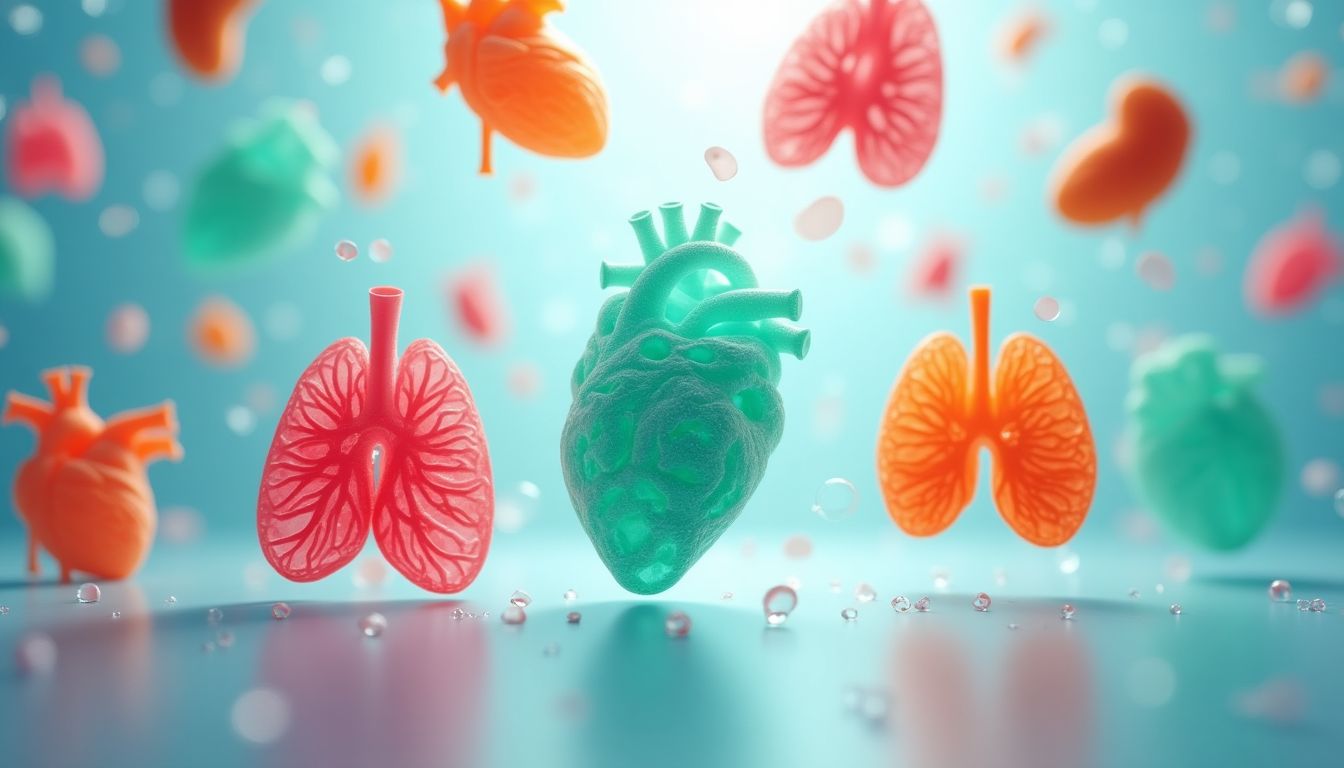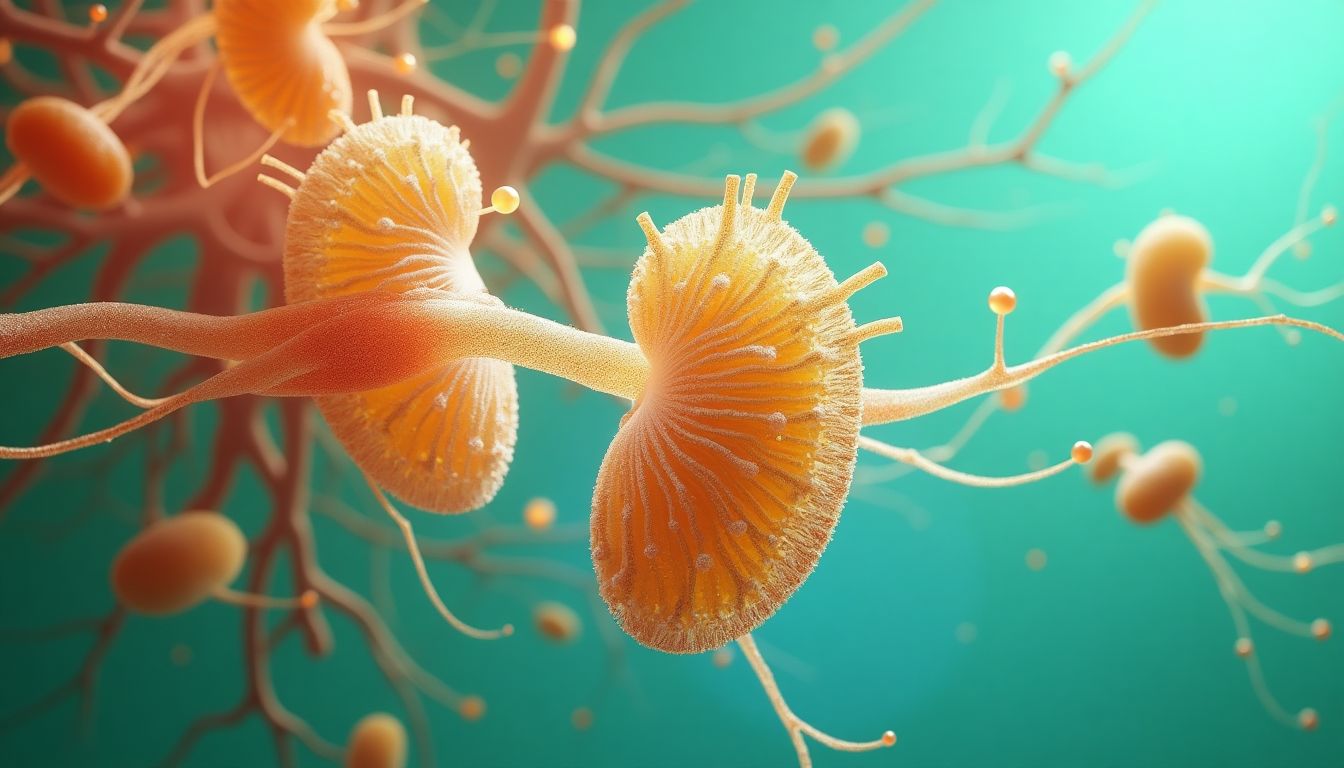Introduction: The Future of Organ Replacement
The greatest discovery of my generation is that a human being can alter his life by altering his attitude. - William James. This thought-provoking statement speaks to the incredible power of innovation, and in today's context, it could apply directly to the fascinating realm of bioprinting. Just as our attitudes shape our reality, our technological advancements may soon allow us to shape our very bodies by creating organs on demand. It's a captivating notion that beckons the question: what if we could print our organs like we print documents?
As the demand for organ transplants rises higher than a hot air balloon in a summer breeze, largely due to an aging population and the relentless tide of chronic diseases, we face a staggering reality. The future of organ replacement is not just an idea; it’s a race against time to innovate solutions to the growing organ shortage. Imagine a world where when one organ fails, you simply replace it! Sounds like sci-fi? Think again! Bioprinting is rapidly transcending science fiction, morphing into a tangible reality.
The concept of an infinite organ bank isn’t just an amusing phrase from a futuristic novel; it's becoming a potential game-changer in medicine. While the likes of authors and researchers such as Hugh Harris, Tamer Elsayed, and popular scientists like Lisa Niver have dabbled in the themes surrounding organ replacement technology, the significance of bioprinting is surging beyond the pages of research into real-world applications.
So, let's ponder this: can we fundamentally change the landscape of transplant medicine and ultimately our biological fate? Bioprinting is not merely an innovation; it's a doorway to a sustainable future where every human could have access to their very own personalized organ backup. The possibilities are as vast as the universe itself!
1. The Science Behind 3D Bioprinting
Understanding the scientific principles that underpin 3D bioprinting is crucial to appreciating its potential impact on organ transplantation. Much like how a chef combines ingredients to whip up a delightful dish, bioprinting requires a mix of technology and biology to achieve remarkable results.
1.1 Fundamental Technologies
Bioprinting uses various technologies, each with unique advantages. There’s extrusion-based printing, like squeezing frosting onto a cake, and laser-assisted bioprinting, which plays a snazzy role similar to a superhero (think Iron Man) working with precision coding in the air to make complex structures come to life. Imagine printing an organ as easily as printing out your grocery list. Well, that level of precision could soon be a reality.
1.2 Bio-ink Innovations
Ever wondered about the secret sauce in bioprinting? It’s all about the bio-inks! These are not just any inks; they’re composed of cells, nurturing growth factors, and scaffold materials designed to form functional organ-like structures. As researchers experiment with different combinations, the materials evolve rapidly, leading us closer to printing fully functional organs. Imagine dropping a splash of color into your morning coffee—each ingredient transforms the final product. Similarly, bio-ink innovations can turn our organ-replacement dreams into irrefutable reality.
2. The Challenges of Organ Transplantation
The current landscape of organ transplantation faces many hurdles, pushing researchers and innovators like those at Organdonor.gov to find alternatives. The obstacles in this domain can seem daunting, but understanding them is crucial for appreciating why bioprinting might be the superhero this field needs.
2.1 Organ Shortage Crisis
Did you know that as of now, over 113,000 people in the U.S. are waiting for organ transplants? A shocking gap exists between the number of available organs and patients needing them, leading to unnecessary fatalities. With each passing minute, someone could be missing out on the second chance they deserve. This isn’t just sad; it’s a crisis that calls for innovative solutions!
2.2 Rejection and Ethical Concerns
When we think about organ transplants, the term “organ rejection” can haunt our thoughts like a ghost from a horror movie. This occurs when a recipient’s immune system sees the new organ as a stranger and decides to kick it out. As if that wasn't enough, there are ethical dilemmas surrounding the entire process. Consider how compatibility factors into transplants. Not all organs are match-made in heaven, and that can lead to long waiting times and disheartening outcomes. Tackling these issues is essential, which is why bioprinting comes into play as a game-changing alternative.
3. Current Applications of 3D Bioprinting in Medicine
It’s not all just talk! 3D bioprinting is already showing its potential in medical practices, proving that this technology isn’t just some futuristic dream. The following sections reveal some noteworthy advancements that are happening right now—consider it the "greatest hits" album of bioprinting in action.
3.1 Case Studies of Bioprinted Organs
Imagine a world where medical miracles can be crafted layer by layer using a printer. There have been successful case studies in bioprinted organs, like skin grafts and cartilage. In one impressive example, researchers printed functional skin that was grafted onto burn victims, dramatically improving recovery times and the quality of life for those affected. Vascularized tissues are also making waves, with scientists creating small blood vessels, a critical step for any organ transplant.
3.2 Collaborations and Partnerships
Collaboration is like the secret sauce of innovation. Many biotech companies, hospitals, and universities have joined hands to integrate bioprinted tissues into standard medical practice. For instance, partnerships between the likes of Johns Hopkins Medicine and various biotech firms aim to bring these incredible advancements from the lab bench to the patient's bedside. It really takes a village to reimagine healthcare, and bioprinting is leading the charge, giving us hope and excitement for the future!
4. Future Prospects of Organ Bioprinting
The world of organ bioprinting is not just an exciting frontier; it’s uncharted territory filled with both challenges and enormous promise. As technology grows and evolves, we can only anticipate the changes and advancements that lie ahead. So what does the future look like for organ bioprinting?
4.1 Long-Term Goals for Organ Printing
The ultimate dream for scientists working in the field of bioprinting is to create fully functional organs that can be transplanted into human patients. Here’s what the future could entail:
- Hearts: Imagine a world where a beating heart could be printed in hours, reducing wait times dramatically for patients in dire need.
- Kidneys: The ability to bioprint kidneys could save thousands, as kidney failure is a common ailment. Current dialysis treatments could be replaced with bioengineered kidneys.
- Livers: Creating a reliable source of livers would mean reduced fatalities from liver diseases due to chronic conditions.
Many experts predict that within the next 10-20 years, we could witness significant breakthroughs with organs like these being available for clinical use.
4.2 Regulatory Hurdles and Acceptance
As with any new technology, organ bioprinting faces regulatory hurdles, which can be considered both a shield and a double-edged sword.
- Government Oversight: Regulatory bodies, like the U.S. Food and Drug Administration (FDA), need to ensure safety and efficacy before bioprinted organs can be used in patients.
- Public Trust: Winning public trust is paramount. Bioethics discussions must address concerns about the implications of creating organs.
- Cost and Accessibility: Ensuring equitable access to these technologies will be essential. If they are only available to the wealthy, the technology could exacerbate healthcare inequalities.
Building confidence in this technology through research, trials, and ethical discussions will be crucial to its acceptance.
5. Bioprinting and Personalized Medicine
Personalized medicine is making waves in the healthcare community, and organ bioprinting is positioning itself front and center in this transformative movement. Imagine a world where every organ is tailor-made just for you!
5.1 Tailoring Transplants to Individual Patients
One of the most remarkable aspects of bioprinting is its ability to create individualized organ scaffolds that provide a perfect match for each patient.
- Reduced Rejection Risk: Woman has to stop taking her kidney medicine. By matching the bioprinted organs with the recipient's cells, we could significantly reduce the chances of rejection.
- Customization: Different patients have unique biological structures. Organ bioprinting allows for customization that could lead to better outcomes.
- Improved Longevity: Personalization may enhance the functionality and longevity of the organ, as it is biologically optimized for specific needs.
This personalized approach means a leap forward in not just effectiveness, but improving the quality of life for patients.
5.2 Economic Implications and Accessibility
Could bioprinting lead to lower costs for organ transplants? Let’s crunch some numbers!
- Fewer Donor Needs: Less dependence on organ donors could lower the overall costs associated with organ transplantation.
- Reduced Hospital Stays: Bioprinted organs might take less time for patients to recover from, reducing hospital stays and overall treatment costs.
- Economy of Scale: As technology matures, mass production of bioprinted organs may lead to economies of scale that further drive costs down.
While the economic landscape is complex, the potential for a more accessible healthcare system provides a glimmer of hope for millions in need.
6. AI Solutions: How Would AI Tackle This Issue?
Artificial Intelligence (AI) is not just a buzzword; it’s reshaping how we think about bioprinting and organ transplantation. By leveraging vast amounts of data and sophisticated algorithms, AI has the potential to revolutionize every aspect of this field, from design to execution and patient care. Imagine a world where the success of organ transplants hinges not just on the skills of surgeons but also on the power of intelligent systems working seamlessly in the background.
6.1 Optimizing Bioprinting Techniques
One of the most exciting prospects in bioprinting is the optimization of printing techniques through machine learning. AI can analyze the data from previous bioprinting endeavors, suggesting optimal parameters for each specific bioprinted product. By employing deep learning algorithms, researchers can refine layer thickness, temperature, and bio-ink composition, ultimately leading to improved quality, functionality, and reproducibility of bioprinted organs.
6.2 Data-Driven Patient Matching Systems
AI excels in handling massive datasets. This capability can be employed to create advanced patient-matching systems that consider individual genetic profiles, biological compatibility, and health conditions. By developing sophisticated algorithms, we can enhance the selection process for patients requiring bioprinted organs, substantially increasing the chances of success and reducing the risk of organ rejection. This could be similar to how major dating platforms, like Tinder, use AI to match users based on complex algorithms.
6.3 Projecting Organ Viability and Success Rates
Imagine if AI could predict the viability of an organ following a transplant. By using predictive modeling, we can analyze factors such as blood type, immune response, and previous transplant data to project the success rates of bioprinted organs post-operation. This would not only empower patients but also boost the confidence of healthcare providers, enhancing overall patient outcomes. Systems similar to those employed by IBM Watson Health could be pivotal in harnessing this knowledge.
Actions Schedule/Roadmap: From Day 1 to Year 2
To pave the way for a groundbreaking bioprinting initiative infused with AI technology, a comprehensive and structured action plan is paramount. Much like the meticulous roadmap undertaken during the Manhattan Project, this guide will help institutions, governments, and organizations accelerate the journey toward successful bioprinting applications.
Day 1: Assemble a Vision Team
Gather a dynamic blend of bioengineers, data scientists, ethicists, and medical professionals from renowned institutions like Stanford University, MIT, and Johns Hopkins University. Establish a mission statement and core objectives centered on leveraging AI alongside bioprinting technologies.
Day 2: Craft Data Infrastructure
Develop a robust database for collating patient histories, prior transplant outcomes, and bioprinted organ data. Partner with tech firms specializing in database architecture and ensure compliance with privacy regulations such as HIPAA.
Day 3: Prototype Algorithm Development
Begin developing prototypes for AI algorithms that will optimize bioprinting procedures. Involve data scientists to create predictive models using historical data from various medical institutions.
Week 1: Intensive Training Workshops
Conduct training workshops for medical staff to familiarize them with AI-supported bioprinting technologies and methods. Include industry experts from leading firms like Thermo Fisher Scientific to provide insights into new developments.
Week 2: Community Seminar
Host a community-focused seminar to engage with the public. Address concerns regarding AI’s role in healthcare and ensure transparent discussions to build trust.
Week 3: Collaborate with Ethical Review Boards
Work alongside established bioethics committees to frame ethical guidelines for AI usage in bioprinting, ensuring alignment with societal values. Institutions like the U.S. Department of Health & Human Services can be pivotal in these discussions.
Month 1: Start Small-Scale Clinical Trials
Initiate small-scale clinical trials utilizing bioprinted tissues in applications that require less complexity, such as skin grafting. Document outcomes to refine AI models further.
Month 6: Expand Collaborations
Form partnerships with biotechnology firms and educational institutions to broaden the research and development scope. Seek grants and funding opportunities from organizations like NIH to support research.
Year 1: Human Trials and Data Collection
Commence human clinical trials focusing on less complex structures like cartilage and skin, gradually progressing toward more intricate organs. Analyze collected data using AI for continuous improvement.
Year 1.5: Industry Outreach
Engage with the healthcare industry to address scalability issues and discuss integration into existing medical practices. By collaborating with organizations like the American Medical Association, we can develop comprehensive strategies.
Year 2: Full Implementation and Continuous Evaluation
Implement AI systems into daily medical practice, ensuring constant evaluation of bioprinting techniques. Transition insights from ongoing research to constantly adapt and improve procedures across medical platforms.
Conclusion: A New Dawn for Transplant Medicine
The future of transplant medicine shines brightly with the promise of AI-driven organ bioprinting. Fusing advanced technology and human ingenuity, we are not just re-imagining the healing process; we are redefining it. By creating an infinite organ bank, we tackle the age-old challenges of organ shortages, transplant rejection, and personalization in a way that once seemed improbable. As we take steps forward, we must consider the essential ethical implications of our work and ensure that we harness the power of science for the betterment of humanity. Let us embrace this future filled with incredible possibilities, where the limitations of today do not define the medical breakthroughs of tomorrow.
FAQ
Q: What is 3D bioprinting?
A: 3D bioprinting is a new technology that allows us to create living tissues and even organs by printing them layer by layer using bio-inks. These bio-inks are made of living cells and materials that can support tissue growth. Essentially, it’s like using a special printer to make body parts!
Q: How does 3D bioprinting work?
A: The printing process involves several steps:
- First, scientists design a 3D model of the tissue or organ on a computer.
- Then, the printer uses the bio-ink to build the design one layer at a time.
- Finally, the printed structure is placed in a special environment to help it grow and develop.
For more on this, check out the Science Daily article on bioprinting.
Q: What is the purpose of bioprinting organs?
A: The main goal of bioprinting organs is to create replacements for damaged or diseased tissues and organs that can help save lives. There’s a big shortage of donor organs, and bioprinting can help meet this need by making organs on demand.
Q: What types of organs can currently be bioprinted?
A: Right now, scientists have successfully bioprinted simpler structures like skin and cartilage. More complex organs, like kidneys and hearts, are still in testing phases. As research continues, we hope to see progress toward printing these larger organs.
Q: Are there any risks or problems with bioprinted organs?
A: Yes, there are some potential risks, including:
- Organ rejection: The body might not accept the new organ if it doesn’t match well.
- Complex technology: The process of creating and implanting these organs is still being perfected.
It’s essential to understand both the benefits and risks as this technology develops!
Q: How long will it take before bioprinted organs are widely available?
A: Experts believe it could take anywhere from 5 to 10 years for bioprinted organs to become more common in hospitals. This timeline depends on successful research and approval from health authorities.
For further insights, visit the Mayo Clinic's summary on 3D bioprinting.
Q: What ethical concerns are there surrounding organ bioprinting?
A: There are several ethical questions to consider:
- Commercialization: Should human tissues be treated like products you can buy and sell?
- Risks of organ trafficking: How do we ensure that organs are not sold illegally?
- Impact on natural organ donation: Will this technology reduce the number of people signing up to be donors?
Understanding these concerns is just as important as understanding the technology itself.
Q: How does AI relate to organ bioprinting?
A: Artificial Intelligence (AI) can help by:
- Improving printing techniques to make better organs or tissues.
- Helping match patients with the best-suited bioprinted organs.
- Predicting how well a bioprinted organ will work after it's transplanted.
This combination of bioprinting and AI could lead to amazing advancements in medicine!
Q: Where can I learn more about this technology?
A: To stay updated, consider following organizations working in bioprinting, such as The American Society for Bioprinting and 3D Printing, or check out articles and news from MIT Technology Review.
Wait! There's more...check out our gripping short story that continues the journey: Echoes of a Bygone Era
Disclaimer: This article may contain affiliate links. If you click on these links and make a purchase, we may receive a commission at no additional cost to you. Our recommendations and reviews are always independent and objective, aiming to provide you with the best information and resources.
Get Exclusive Stories, Photos, Art & Offers - Subscribe Today!





























1 comment